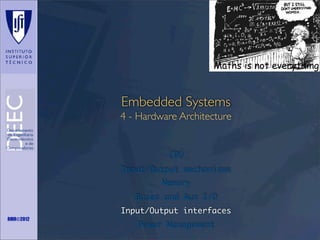Mais conteúdo relacionado
Semelhante a S emb t8-arch_itfio (20)
Mais de João Moreira (11)
S emb t8-arch_itfio
- 1. Maths is not everything
Embedded Systems
4 - Hardware Architecture
CPU
Input/Output mechanisms
Memory
Buses and Aux I/O
Input/Output interfaces
RMR©2012
Power Management
- 4. DB9 pinout of a DTE
DTE vs DCE
Pinout of a DCE?
Common ground?
Noise effects?
Maths is not everything
RMR©2012
- 8. What is SPI?
Serial bus protocol
Fast, easy to use, and simple
Very widely used
Not “standardized”
Maths is not everything
RMR©2012
- 9. SPI Basics
A 4-wire communications bus
Typically communicate across short
distances
Supports
Single master
Multiple slaves
Synchronized
Maths is not everything
RMR©2012
Communications are “clocked”
- 10. SPI Capabilities
Always full-duplex
Communicates in both directions simultaneously
Transmitted (or received) data may not be meaningful
Multiple Mbit/s transmission speeds
0-50 MHz clock speeds not uncommon
Transfer data in 4 to 16 bit characters
Maths is not everything
RMR©2012
Supports multiple slaves
- 11. SPI bus wiring
Bus wires
Master-Out, Slave-In (MOSI)
Master-In, Slave-Out (MISO)
System Clock (SCLK)
Slave Select/Chip Select (SS1#, …, SS#n or CS1, …,
CSn)
Master asserts slave/chip select line
Maths is not everything
RMR©2012
Master generates clock signal
Shift registers shift data in and out
- 12. SPI signal functions
MOSI – carries data out of master to slave
MISO – carries data out of slave to master
Both MOSI and MISO are active during every
transmission
Maths is not everything
RMR©2012
SS# (or CS) – unique line to select each
slave chip
SCLK – produced by master to synchronize
transfers
- 13. SPI uses a “shift register” model of communications
Master shifts out data to Slave, and shifts in data from Slave
Maths is not everything
RMR©2012
- 14. Two bus configuration models
Maths is not everything
RMR©2012
Master and multiple independent
slaves
Master and multiple daisy-chained
slaves
- 15. SPI clocking: there is no “standard way”
Four clocking “modes”
Two phases
Two polarities
Master and selected slave must be in the same mode
During transfers with slaves A and B, Master must
Configure clock to Slave A’s clock mode
Select Slave A
Do transfer
Deselect Slave A
Configure clock to Slave B’s clock mode
Maths is not everything
Select Slave B
Do transfer
RMR©2012
Deselect Slave B
Master reconfigures clock mode on-the-fly!
- 18. SPI tradeoffs: the pros and cons
Pros
Fast for point-to-point connections
Easily allows streaming/constant data inflow
No addressing in protocol, so it’s simple to implement
Broadly supported
Cons
Slave select/chip select makes multiple slaves more complex
No acknowledgement (can’t tell if clocking in garbage)
No inherent arbitration
Maths is not everything
RMR©2012
18
No flow control (must know slave speed)
- 20. I2C bus
Inter-Integrated Circuit
Two wire serial bus specification
Designed for low-cost, medium data rate
applications.
Several microcontrollers come with built-in
I2C controllers.
Invented by Philips in the early 1980s
Maths is not everything
RMR©2012
20
The division is now NXP
Was a patented protocol, but patent has now expired
- 22. I2C details
Two-wire serial protocol with addressing
capability
Speeds up to 3.4 Mbps
What limits I2C to such small speeds?
Multi-master architecture
Open collector bus driver
Pull-up resistors
Maths is not everything
RMR©2012
22
Multi-master, Multi-slave
Uses bus arbitration
- 23. I2C physical layer
Two lines
Open collector design
SDA (serial data)
Simple interfacing for multi-voltage
SCL (serial clock)
Supports bus arbitration
master 1
master 2
data line
SDA
clock line
SCL
slave 1
+
SDL
+
Maths is not everything
SCL
RMR©2012
23
slave 2
- 24. I2C signaling
Sender pulls down bus for 0.
Sender listens to bus---if it tried to send
a 1 and heard a 0, someone else is
simultaneously transmitting.
Maths is not everything
RMR©2012
© 2008 Wayne Wolf
Transmissions occur in 8-bit bytes.
- 25. I2C clock
Not a “traditional” clock
Normally is kept “high” using a pull-up
Pulsed by the master during data
transmission
Master could be either the transmitter or receiver
Slave device can hold clock low if needs
more time
Allows for flow control
Maths is not everything
RMR©2012
25
- 26. I2C transaction
Transmitter/receiver differs from
master/slave
Master initiates transactions
Slave responds
Transmitter sets data on SDL line, slave
acks
Maths is not everything
RMR©2012
26
For a read, slave is transmitter
For a write, master is transmitter
- 27. I2C bus transactions: start and stop conditions
Master pulls SDA low while SCL is high
Normal SDA changes only happen when SCL is
low
Master pulls SDA high while SCL is high
Maths is not everything
Also used to abort transactions
RMR©2012
34
- 28. I2C address transmission
Data is always sampled on the rising clock
edge
Address is 7 bits
An 8-th bit indicated read or write
High for read
Low for write
Addresses assigned by Philips/NXP
Maths is not everything
For a fee
Was covered by patent
RMR©2012
28
- 29. I2C data transmission
Transmitted just like address (8 bits)
For a write, master transmits, slave acknowledges
For a read, slave transmits, master acknowledges
Transmission continues
Subsequent bytes sent
Continue until master creates stop condition
Maths is not everything
RMR©2012
29
- 30. I2C bus arbitration
Sender listens while sending address.
Maths is not everything
RMR©2012
© 2008 Wayne Wolf
When sender hears a conflict, if its
address is higher, it stops signaling.
Low-priority senders relinquish control
early enough in clock cycle to allow bit to
be transmitted reliably.

